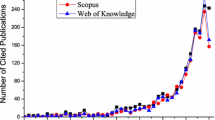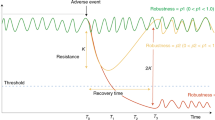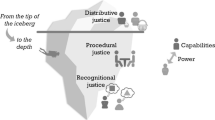Abstract
This paper focuses on the analysis and evaluation of resilience anchored in an economic perspective. Resilience, as well as most of the benefits provided by ecosystems, is not priced on current markets. However, this does not mean that resilience is of no value for humans. On the contrary, the interest of using an economic perspective, and the respective scientific methodology, will be put forward in terms of resilience relevance for ecosystem functioning, and its impact on human welfare. The economic perspective is anchored in an anthropocentric analysis evaluating resilience in terms of provision of natural capital benefits. These in turn are interpreted as insurance against the risk of ecosystem malfunctioning and the consequent interruption of the provision of goods and services to humans. For this analysis, we make use of a conceptual framework that identifies and describes the different value components of resilience. Finally, we present an illustration that discusses the economic analysis of resilience benefits in the context of the Venice Lagoon.
Similar content being viewed by others
References
Aronsson T, Johansson P-O, Lofgren K-G (1997) Welfare measurement, sustainability and ‘green’ accounting—a growth theoretical approach. Edward Elgar, Cheltenham, UK and Lyme, USA
Barbier EB, Burgess J, Folke C (1994) Paradise Lost? The ecological economics of biodiversity. Earthscan Publications Limited, London
Batabyal AA, Kahn JR, O’Neill RV (2003) On the scarcity value of ecosystem services. J Environ Econ Manage 46:334–352
Beisner BE, Haydon DT, Cuddington K (2003) Alternative stable states in ecology. Front Ecol Environ 1(7):376–382
Boardman A, Greenberg D, Vining A, Weimer D (2000) Cost benefit analyis: concepts and practice, 2nd edn. Prentice Hall
Breil M, Gambarelli G, Nunes PALD (2005) Economics valuation of on-site material damages of high water on economic activities based in the city of Venice: results from a dose-response-expert-based valuation approach. In: Fletcher CA, Spencer T, with Da Mosto J, Campostrini P (eds) Flooding and environmental challenges for venice and its lagoon: state of knowledge. Cambridge University Press, Cambridge
Brock WA, Maler K-G, Perrings CA (2000) Resilience and Sustainability: The Economic Analysis of Non-Linear Dynamic Systems, Discussion Paper n. 133. The Beijer International Institute of Ecological Economics
Cajaraville MP, Diez I, Gorostiaga JM, Etxebarria N, Astorkiza I, Tarazona JV, Diez G (2005) Integrated assessment of the effects of the Prestige oil spill in Galizia and the Biscay Gulf: toxicological, ecological, productive and socioeconomical aspects (Prestepse), VERTIMAR-2005, SYMPOSIUM for monitoring of Accidental Oil Spill Projects in Marine Environment related with VEM2003 Program of Ministry of Education and Science (Spain)
Cardona OD (2003) The need for rethinking the concepts of vulnerability and risk from a holistic perspective: A necessary review and criticism for effective for effective risk management. In: Bankoff G, Frerks G, Hilhorst D (eds) Mapping the vulnerability: disasters, development and people. Earthscan Publishers, London
Carraro C, Nunes PALD (2004) Valutazione economica degli impatti di breve periodo del fenomeno delle acque alte sulle attività economiche della città di Venezia. Rapporto Finale, Comune di Venezia, CORILA
Carpenter SR, Ludwig D, Brock WA (1999) Management of eutrophic for lakes subject to potentially irreversible change. Ecol Appl 9:751–771
Carson RT, Mitchell RC, Hanemann WM, Kopp RJ, Presser S, Ruud PA (1992) A contingent valuation study of lost passive use values resulting from the exxon valdez oil spill. Report prepared for the Attorney General of the State of Alaska, Washington, USA
CBD—Convention on Biological Diversity (2001) Biodiversity Global Outlook, http://www. biodiv.org, cited 15 Apr 2005
Christianou M, Ebenman B (2005) Keystone species and vulnerable species in ecological communities: strong or weak interactors? J Theor Biol 235(1):95–103
De Leo GA, Levin S (1997) The multifaceted aspects of ecosystem integrity. Conserv Ecol 1(1):3
Deutsch L, Folke C, Skanberg K (2002) The Critical Natural Capital of Ecosystem Performance as Insurance for Human Well-Being, Discussion Paper n. 156. The Beijer International Institute of Ecological Economics
Ehrenfeld D (1988) Why put a value in biodiversity. In: Wilson EO (ed) Biodiversity. National Academy Press, London, UK
El Serafy S (1999) Steering the right compass: proper measurements for sound macro-economic management, Paper presented at International symposium valuation of nature and environment. Royal Netherlands Academy of Arts and Sciences, Amsterdam, The Netherlands
Folke C, Holling CS, Perrings C (1996) Biological diversity, ecosystems and the human scale. Ecol Appl 6(4):1018–1024
Freeman PK, Martin LA, Linnerooth-Bayer J, Mechler R, Pflug G, Warner K (2003) Disaster risk management, national systems for the comprehensive management of disaster risk and financial strategies for natural disaster reconstruction, inter-American development bank, sustainable development department, environment division, integration and regional programs department, regional policy dialogue, Washington DC, USA
Fromm O (2000) Ecological structure and functions of biodiversity as elements of its total economic value. Environ Resour Econ 16:303–328
Gerlagh R, Dellink R, Hofkes M, Verbruggen H (2002) A measure of sustainable development for the Netherlands. Ecol Econ 41:157–174
Gunderson LH (2000) Ecological resilience—in theory and application. Annu Rev Ecol Syst 31:425–439
Hanley N, Spash CL (1993) Cost-benefit analysis and the environment. Edward Elgar, Aldershot, UK and Brookfield, USA
Hardin G (1968) The tragedy of the commons. Science 162:1243–1248
Hueting R (1980) New scarcity and economic growth. North-Holland, Amsterdam, The Netherlands
Holling CS (1973) Resilience and stability of ecological systems. Annu Rev Ecol Syst 4:1–23
Holling CS (1986) The resilience of terrestrial ecosystem: local surprise and global change. In: Clark WC, Munn RE (eds) Sustainable development of the biosphere, International Institute for Applied Systems Analysis (IIASA). Cambridge University Press, Cambridge
Holling CS, Schindler DW, Walker BW, Roughgarden J (1995) Biodiversity in the functioning ofecosystems: an ecological synthesis. In: Perrings Ch (ed) Biodiversity loss. Economic and ecological issues. Cambridge University Press, Cambridge
Holling CS (1996) Engineering resilience vs ecological resilience. In: Schulze PC (ed) Engineering within ecological constraints. National Academy Press, Washington, DC
Keuning ST, de Haan M (1996) What is a NAMEA? Statistics Netherlands National Accounts Paper, Voorburg, The Netherlands
Johnson KH, Vogt KA, Clark HJ, Schmitz OJ, Vogt DJ (1996) Biodiversity and the productivity and stability of ecosystems. Trend Ecol Evol 11:372–377
Maltby E, Hogan DV, McInnes RJ (eds) (1996a) Functional Analysis of European Wetland Ecosystems, Final Book—Phase One, EC DGXII STEP Project CT90–0084. Wetland Ecosystems Research Group, University of London, UK
Maltby E, Hogan DV, McInnes RJ (eds) (1996b), The functioning of River Marginal Wetlands-Improving the Science-base for the Development of Procedures of Functional Analysis, Commission of the European Communities, DG XII, Environment and Waste Recycling, Water Pollution Research Book Series
Millenium Ecosystem Assessment (2005) Ecosystems and human well-being: synthesis. Island Press, Washington, DC
Miller KR, Furtado J, Klemm C, McNeely JA, Myres N, Soule ME, Texton MC (1985) Maintaining biological diversity. The key factor for a sustainable society. JUCN, Gland, Switzerland
Ministero dei Lavori Pubblici, Magistrato delle Acque (1997), Nuovi interventi per la salvaguardia di Venezia, Interventi alle bocche lagunari per la regolazione dei flussi di marea, Studio di impatto ambientale del progetto di massima, Allegato 3, Studi socio-economici: parte B
Ministero dell’Ambiente (1998) Valutazione di impatto ambientale relativa al progetto: Interventi alle bocche lagunari per la regolazione dei flussi di marea, Studio di impatto ambientale del progetto di massima, Parere di compatibilità ambientale della Commissione per le Valutazioni di Impatto ambientale
Mooney HA, Lubchenco J, Dirzo R, Sala OE (1995) Biodiversity and ecosystem functioning: basic principles. In: Heywood VH (ed) Global biodiversity assessment. UNEP Cambridge University Press, Cambridge
Muradian R (2001) Ecological thresholds: a survey. Ecol Econ 38:7–24
Nijkamp P, Rietveld P, Voogd H (1991) Multicriteria evaluation in physical planning. North-Holland, Amsterdam, The Netherlands
Nordemar I, Kautsky H (2002) Human influence and degradation of coral reefs in the Gulf of Thailand. Proceedings of the 9th International Coral Reef Symposium 2:1047–1052
Nunes PALD, van den Bergh JCJM (2001) Economic valuation of biodiversity: sense or nonsense. Ecol Econ 39:203–222
Nunes PALD, van den Bergh JCJM, Nijkamp P (2003) The ecological economics of biodiversity. Methods and policy applications. Edward Elgar, Cheltenham
Odum HT (1950) Bird populations of the highlands plateau in relation to plant succession and avian invasion. Ecology 31:587–605
OECD (1997) Experience with the use of trade measures in the convention of international trade in engendered species of wild fauna and flora (Cites). Paris
Paine RT (1969) The Pisaster-Tegula interaction: prey patches, predator food preference, and intertidal community structure. Ecology 50:950–961
Pearce D, Markandya A, Barbier EB (1989) Blueprint for a green economy. Earthscan Publications Ltd, London
Pearce DW, Moran D (1994) The economic value of biodiversity. Earthscan, London
Perrings C, Opschoor H (1994) The loss of biological diversity: some policy implications. In: Turner K et al (eds) Ecosystems and nature. Edward Elgar, London
Perrings C (1998) Resilience in the dynamics of economy-environment systems. Environ Resour Econ 11(3–4):503–520
Perrings C, Stern DI (1999) Modelling loss of resilience in agroecosystems: rangelands in Botswana. Environ Resour Econ 16:185–200
Pimm SL (1984) The complexity and stability of ecosystems. Nature 307:321–326
Pimm S, Russell G, Gittleman J, Brooks T (1995) The future of biodiversity. Science 269:347–350
Prakash TNR, Pearce D (1993) Sustainability as resilience: measuring sustainable development, unpublished
Reggiani A, de Graaf T, Nijkamp P (2002) Resilience: an evolutionary approach to spatial economic systems. Netw Spatial Econ 2:211–229
Rose A (2004) Defining and measuring economic resilience to disasters. Disaster Prevent Manage 13(4):307–314
Scheffer M, Hosper SH, Meijer ML, Moss B (1993) Alternative equilibria in shallow lakes. Trends Evol Ecol 8:275–279
Simon H, Wildavsky A (1995) Species revisited. In: Simon J (ed) The state of humanity. Blackwell, Oxford, UK
Turner RK, van den Bergh JCJM, Barendregt A, Maltby E (1998) Ecological-economic analysis of wetlands: science and social science integration. In: Söderquist T (ed) Wetlands: landscape and institutional perspectives, Beijer Occasional Paper Series. Beijer International Institute of Ecological Economics, Stockholm, Sweden
Van Ierland EC, de Kruijf HAM, van der Heide CM (1998) Attitudes and the value of biodiversity, A paper on biodiversity valuation & statements by participants of Benin, Bhutan, Costa Rica and The Netherlands at the workshop ‘Biodiversity Valuation in Cultural Context’, March 2–7, San Josè, Costa Rica
Van Kooten GC, Bulte EH (2000) The economics of nature. Managing biological assets. Blackwell Publishers, Malden
Walker BH (1992) Biological diversity and ecological redundancy. Conserv Biol 6:18–23
Walker BH (1995) Conserving biological diversity through ecosystem resilience. Conserv Biol 9(4):747–752
Westman RE (1985) Ecology, impact assessment and environmental planning. Wiley, Chichester, UK
Wilson EO (ed) (1988a) Biodiversity. National Academy Press, London, UK
Author information
Authors and Affiliations
Corresponding author
Rights and permissions
About this article
Cite this article
Vergano, L., Nunes, P.A.L.D. Analysis and evaluation of ecosystem resilience: an economic perspective with an application to the Venice lagoon. Biodivers Conserv 16, 3385–3408 (2007). https://doi.org/10.1007/s10531-006-9085-y
Received:
Accepted:
Published:
Issue Date:
DOI: https://doi.org/10.1007/s10531-006-9085-y




